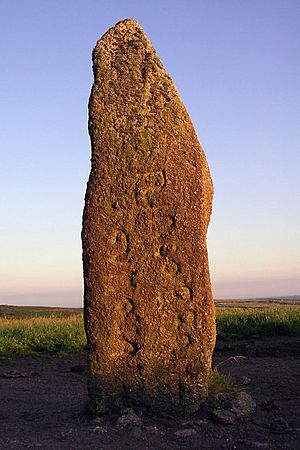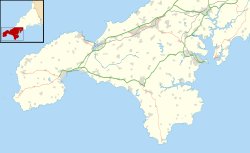Mên Scryfa facts for kids

Mên Scryfa illuminated by the setting sun.
|
|
| Location | Cornwall |
|---|---|
| Coordinates | 50°09′44″N 5°36′12″W / 50.162238°N 5.603314°W |
| Type | Standing stone |
| History | |
| Periods | Early middle ages |
Mên Scryfa (also spelled Mên Scrifa) is an ancient standing stone found in Cornwall, United Kingdom. Its name means "stone with writing." This special stone has an inscription from the early medieval period. The writing on it remembers a person named "Rialobranus, son of Cunovalus."
Contents
Where is Mên Scryfa Located?
Mên Scryfa stands in the middle of a field in Cornwall. It is close to the road that connects the villages of Madron and Morvah. Not far from Mên Scryfa, about 300 meters to the south, you can find the famous prehistoric stones known as Mên-an-Tol.
What Does the Stone Look Like?
The Mên Scryfa stone is about 1.7 meters (or 5.5 feet) tall. It has a shape that is roughly rectangular. Its sides measure about 0.4 meters by 0.5 meters. The special writing is carved into the northern side of the stone. However, the very bottom part of the writing is buried in the ground.
Long ago, people said there were two plain crosses carved near the top of the stone. Today, you can still clearly see the horizontal line of the lower cross. But the vertical line is very hard to see. The smaller cross that was supposedly above it can no longer be found at all.
What Does the Inscription Say?
The writing on the stone uses a simpler version of old Roman capital letters. It reads "Rialobrani Cunovali fili." This translates to "Rialobranus, son of Cunovalus."
We don't know much about Rialobranus from other records. He might have been a small king or a leader of a tribe in Cornwall. The name Rialobran (or Ryalvran) could mean "royal raven" in the Cornish language. The name Cunovallos might mean "famous leader" in the British language. So, the inscription could mean "royal raven, son of famous leader."
Some historians used to think that Cunovalus was the same person as Cunobeline. Cunobeline was a famous British king who lived before the Romans arrived.
How Old is the Inscription?
Experts believe the writing on the stone was carved sometime between the 5th and 8th centuries AD. This is based on the style of the letters. However, the stone itself might be much older. It could have been a prehistoric standing stone that was later used for the inscription.
A Brief History of Mên Scryfa
In 1769, a historian named William Borlase wrote about the stone. At that time, it was lying flat on the ground. It was set upright in 1825. But then, in 1849, people looking for treasure knocked it over again.
When John Thomas Blight described it in 1861, it was lying face down. However, around 1862, the stone was set upright once more in its current spot. When it was re-erected, the last word of the inscription ended up being buried underground.
Folklore About the Stone
There's a popular old story about Mên Scryfa. People used to say that a battle happened nearby. They believed that Rialobranus was killed in this battle and buried right where the stone stands. The story also claimed that the stone's length, which is about 9 feet, was exactly the same height as the warrior Rialobranus.
Possible Connections to King Arthur
A genealogist named Peter Bartrum found records of two men named "Cynwal." This name is the Brittonic version of "Cunovalus." Both of these men are part of the same family tree. One Cynwal was named Cynwal Garnwch, and he was the son of Amlawdd Wledig. The other Cynwal was Amlawdd's father, named Cynwal son of Ffrwdwr.
Because of this, Rialobrani (whose modern name would be Rialfran or Rialbran) could have been a cousin to the legendary King Arthur. This would be true if he was the son of Cynwal Garnwch. Or, he could have been King Arthur's great-uncle if he was the son of Cynwal son of Ffrwdwr.


